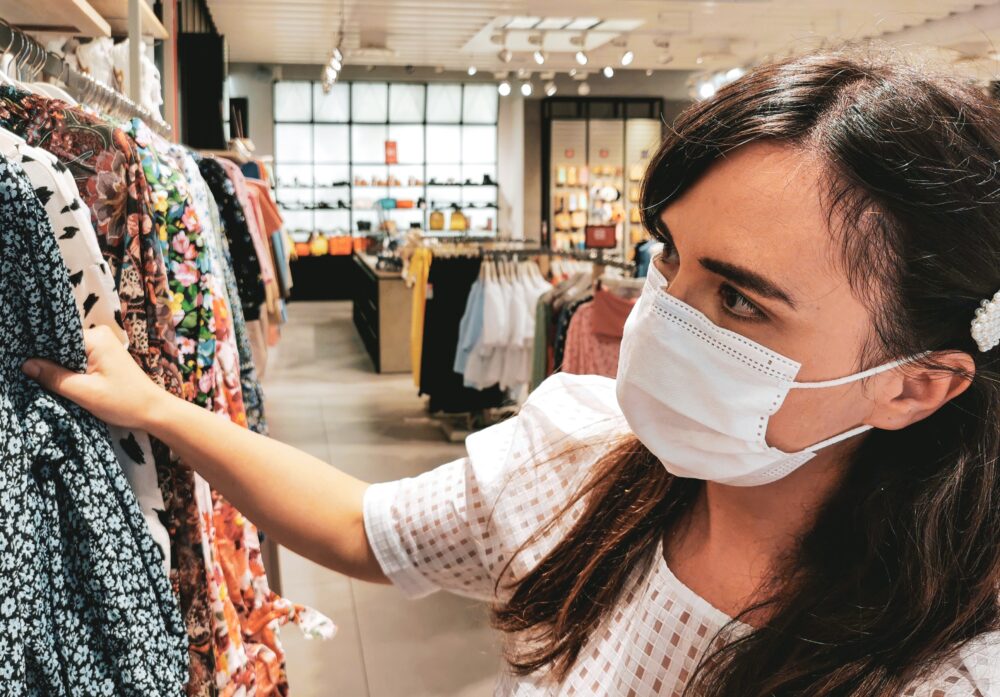Consumer spending declined 7.1 per cent year-on-year in 2020 – as coronavirus restrictions impacted many sectors, with high-street retailers and hospitality hardest hit. Yet there were some bright spots as changing consumer behaviours spurred e-commerce growth, while the rise of the ‘insperience economy’ saw digital services and subscriptions boom as Brits spent more time at home.
Data from Barclaycard, which sees nearly half of the nation’s credit and debit card transactions, reveals that spending on essential items rose by 4.1 per cent year-on-year in 2020. This was largely driven by supermarket shopping, which saw an overall growth of 15.7 per cent, with online grocery shopping surging 70.3 per cent as the demand for delivery services increased. These trends, along with lower prices at the petrol pump, also contributed to a decline in spending on fuel, which dropped by 20.3 per cent.

Turbulent time for high-street retailers and hospitality
Spending on non-essential items contracted 11.3 per cent, as social distancing restrictions had a significant impact on high-street retailers and the hospitality sector. This was especially apparent for department stores which fell by 17.2 per cent and clothing also contracted by 15.6 per cent year-on-year.
🏆
The 2024 Creative Retail Awards are open for entries.
The Creative Retail Awards are much more than a mere accolade; they represent the pinnacle of achievement in the retail industry. Garnering a nomination or winning one of these awards is a testament to innovation, excellence, and leadership.
www.creativeretailawards.com
While the Government’s ‘Eat Out to Help Out’ initiative provided a boost to restaurants after the first national lockdown, restrictive measures throughout the year saw overall spending fall 47.0 per cent. Bars and pubs were inevitably also impacted by social distancing restrictions, seeing an overall drop of 36.7 per cent.
However, there were some bright spots for non-essential retail. Spending at general retailers and catalogues grew by 40.7 per cent and overall, online general retailers saw growth of 52.5 per cent, while physical discount stores saw a 25.4 per cent uplift as more Brits sought value for money in the purchases they made.
Staying local
A key positive outcome of 2020 was that support for independent businesses flourished, as many Brits chose to shop locally. Specialist food and drink stores – which includes off licenses, butchers and bakeries – saw an overall uplift of 28.6 per cent year-on-year. This is supported by Barclaycard’s consumer confidence research, which revealed that over half (57 per cent) of Brits said they wanted to increase their support of nearby businesses as a result of lockdown restrictions.
A trend towards staying local has been seen in travel behaviour too. August and September saw more holidaymakers embark on staycations over trips abroad, with UK hotels, resorts & accommodation seeing their smallest declines since the first national lockdown, at 19.1 per cent and 18.1 per cent respectively – a noticeable improvement on May (-89.8 per cent).
However, overall travel – including airlines and travel agents – declined by 61.1 per cent in August and 63.1 per cent in September, showing the impact of international travel restrictions and quarantine guidelines on the sector.
The growth of the ‘Insperience economy’
As consumers spent more time at home this led to a rise in demand for digital entertainment, services and experiences. Boxsets and games consoles increased in popularity with spending on digital subscriptions and electronics seeing growths of 31.5 per cent and 10.8 per cent respectively. Meanwhile, spending on ordering takeaways online surged 49.1 per cent and those offering services such as meal subscriptions grew by 62.4 per cent, as fresh, hassle-free dinner options became a mainstay in many households.
Boom in home improvements
Many Brits also took the opportunity to spruce up their indoor and outdoor living spaces. After non-essential shops re-opened in June, spending at home improvement & DIY stores surged, driving an overall growth of 9.8 per cent year-on-year. Furniture stores also enjoyed an overall uplift of 5.3 per cent, as shoppers invested in big-ticket purchases.
Consumer escapism and pick-me-ups
Sports & outdoor retailers enjoyed significant growth in 2020, rising 7.2 per cent overall, with the temporary closure of gyms encouraging Brits to purchase workout equipment and seek new ways to exercise inside and outdoors.
Support for florists has also bloomed with purchases up 22.7 per cent as Brits treated themselves and showed friends and family from afar they were missed. Many also took up new hobbies and crafts (9.8 per cent rise) and added new companions to their households, with vets and pets seeing a 10.7 per cent uplift in 2020.
Raheel Ahmed, Head of Consumer Products, said: “2020 has accelerated many trends. E-commerce has seen huge growth, working from home has meant many are shopping more locally and experiences within the home, such as virtual work outs have become the norm. Spending within the retail, travel and hospitality sectors has been acutely impacted. However, we have also seen many businesses become more agile and move online and the demand for online groceries, digital entertainment and subscriptions has been huge. Home improvement, DIY & gardening have also seen a boost, as we all spend more time at home and near our local communities.
Hopefully with a vaccine being rolled out in 2021 we will see green shoots for the most severely impacted sectors. Having said that, some of the trends and changes we’ve seen in customer habits may be here to stay.”
Clare Bailey, Independent Retail Expert and founder of The Retail Champion, “Speaking to retailers, I am encouraged that many are continuing to shop where they live and support local businesses. Whilst those retailers who depended on commuters have been seriously impacted by the reduction in footfall this year, it’s encouraging to see that some of this spend has been transferred to local companies.”
“In addition, in such challenging times, many businesses have also been agile enough to adapt their local offering of products and services to support changing consumer demands. Despite the adversity this year has thrown into the mix, the positive connection which has grown between consumers and their local butchers, bakers or greengrocers is truly heartwarming and a trend I hope continues to thrive in 2021.”














